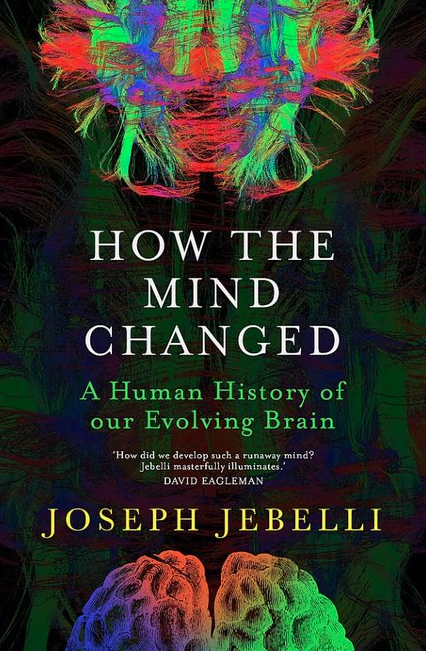Arpan K. Banerjee
Solihull, United Kingdom

The human brain has long been a source of wonder and a fascinating subject for study. Philosophers, scientists, biologists, psychologists, anthropologists, and medical scholars have spent lifetimes studying the brain and how this remarkable organ works. In this book, neuroscientist and author Joseph Jebelli describes the evolutionary development of the human brain in chapters on emotion, memory, intelligence, language, consciousness, neurodiversity, and artificial intelligence.
The brains of early humans were small, measuring only 500 cubic centimeters. The human brain continued to evolve and enlarge, and today is around 1500 cubic centimeters. This is considerably larger than that of early human ancestors such as Australopithecus and Homo erectus. The brain is now an immensely complex structure capable of advanced cognitive functions, language, empathy, and thought. The reason for the development of the larger brain is thought to be a reduction in jaw size and jaw muscles facilitated by a mutation in the MYH16 gene, which played an important role in the large jaw size of non-human primates such as gorillas and chimpanzees.
Early survival circuitry in the human brain included warning systems in harsh environmental times. The amygdala was the site of these warning systems. With evolution, the senses of sight, sound, taste, and touch became more sophisticated. It is interesting that people who have damage to the amygdala may develop affective blindness and are often immune to fear. The amygdala is the site of emotional labeling of memory and emotions with the raw details of memory being processed in the hippocampus.
The American psychologist and philosopher William James in 1884 first postulated that emotions were perceptions related to physiological changes provoked by a stimulus. In 1927, Harvard physiologist Walter Cannon argued that an external event could trigger both a physiological and emotional response simultaneously, with the thalamus playing an important role. Charles Darwin was also interested in this topic and in 1872 published The Expression of the Emotions in Man and Animals. He also postulated that emotions developed through evolution as a survival response. Sigmund Freud believed that emotions were manifestations of the unconscious and were expressed in the conscious state through feelings. Modern neurogenetics, neurophysiology, and neuroanatomy have demonstrated the interplay between emotions and the social aspects of being human.
The chapter on the social brain illustrates that once humans started working in groups, survival was easier. The social nature of humans eventually enabled the development of armies, governments, and other institutions. Empathy, fair play, and justice also became important characteristics of being human.
The chapter on memory is a fascinating one. Humans have reinforcement memories, which helped with remembering things like where food could be hunted. Navigational memory helped with understanding the geography of the environment. The last type of memory to evolve is known as social subject memory, which formed the basis for humans to understand morality.
The subject of memory is followed by a discussion of intelligence. This has always been a controversial subject, ever since methods of measurement for intelligence were introduced by scientists such as Francis Galton and Charles Spearman, who invented the concept of general intelligence. This led to the development of the IQ test by the eugenicist Lewis Terman, an American psychologist. Today we know that some intelligence assessments are culturally defined and unfairly discriminate against specific groups. Nevertheless, it is interesting to note that the overall intelligence of humans continues to increase.
The creation of language is another of the marvels of Homo sapiens. There are thousands of languages around the world, but the majority of the world’s population speaks ten main languages. The development of language depends on social experience. With the development of language, it was possible to pass on stories and information to new generations. This was further facilitated by the invention of the printing press, enabling information to be transmitted in written form.
The chapter on consciousness combines philosophical, psychological, and neurophysiological information with a discussion of free will. The section on neurodiversity discusses autism. The autistic person is regarded by neuroscientists as a person with a different type of mind, rather than viewed through a socially stigmatizing condition, as has been the case in in many cultures.
The book concludes with a discussion about the future of the brain and human beings. Will artificial intelligence and modern neurological and robotic research turn us into different human beings? For example, today we know that some criminal behavior arises from abnormalities in the ventromedial hypothalamus. Perhaps in the future this behavior will be modified. There is even a discussion on cyborgs, conscious artificial intelligence, and transhumanism.
The book is beautifully written, a delight to read, and immensely informative. The seventy pages of notes and references are a reminder of the scholarly research done by the author to produce this fine contribution to popular scientific literature.
How the Mind Changed: A Human History of Our Evolving Brain
Joseph Jebelli
John Murray Publishers UK, 2022
ISBN 9781529300130
ARPAN K. BANERJEE qualified in medicine at St Thomas’s Hospital Medical School, London. He was a consultant radiologist in Birmingham 1995–2019. He was President of the radiology section of the RSM 2005–2007 and on the scientific committee of the Royal College of Radiologists 2012–2016. He was Chairman of the British Society for the History of Radiology 2012–2017. He is Chairman of ISHRAD. He is author/co-author of papers on a variety of clinical, radiological, and medical historical topics and seven books, including Classic Papers in Modern Diagnostic Radiology (2005) and The History of Radiology (OUP 2013).

Leave a Reply